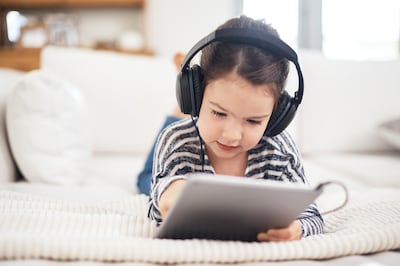For many parents in the digital age, battles over screen time and devices have become a depressing part of family life, and knowing how much is too much has become a moving target.
Whether it's three-year-olds throwing tantrums when the iPad is taken away, seven-year-olds watching YouTube all night, nine-year-olds demanding their own phones, 11-year-olds nagging to play 18-rated video games that "all their friends" are, or 14-year-olds who are never off Instagram, every stage of childhood and adolescence is now accompanied by its own delightful new parenting challenges.
Up until a few years ago parenting advice centred around the concept of “screen time” quotas, with a Goldilocks-style sweet spot of two or so hours of screens a day, beyond which media use could become harmful.
The American Academy of Pediatrics (AAP) still recommends a maximum of one hour of “high-quality programming” for children under 6, but thereafter simply encourages parents to “place consistent limits on the time spent using media” and designate screen-free time as a family.

It’s unclear whether that means four hours playing a video game on a Sunday is okay, or whether it is better to have three 20-minute sessions with the iPad than one hour-long session. Is it really that bad if my 18-month-old watches a couple of episodes of the Twirlywoos before dinner?
Many parents will be relieved to hear that recent research suggests that it’s not so much the length, but the nature of the screen-time that matters. Whether it’s passive TV or social media monitoring, active video game playing, socialising with WhatsApp, or getting creative in iMovie.
Jocelyn Brewer, a psychologist who specialises in the concept of "digital nutrition", likens media diets to what's on our plates: rather than counting calories (or screen time), think about what you're eating.
“It’s not just about whether you consume any potential digital junk foods, but also your relationship to technology and the role it plays in your family life,” says Brewer. “We know that using screens to soothe or pacify kids sets up some concerning patterns of relying on devices to calm or distract a child (or teen, or adult) from their experience of unpleasant or uncomfortable emotions – so we want to avoid using screens to placate tantrums, just like we want to avoid eating ‘treats’ to calm emotional storms.”
For young children, the most important thing is whether parents and kids are playing, watching or browsing together.
A study of 20,000 parents published late last year by the Oxford Internet Institute and Cardiff University determined there was no correlation between limiting device use and children's wellbeing. The study's lead author Dr Andrew Pryzbylski said: "Our findings suggest the broader family context, how parents set rules about digital screen time, and if they're actively engaged in exploring the digital world together, are more important than the raw screen time."
Another study from December by the University of Michigan on people aged four to 11 similarly found that “how children use the devices, not how much time they spend on them, is the strongest predictor of emotional or social problems connected with screen addiction”.

But the authors said that concern over a child’s screen use is warranted when it leads to poor behaviour, loss of interest in other activities, family or social life, withdrawal, or deception.
Most research agrees that although specific screen time limits are dated, there does come a point where excessive device use has negative impacts, affecting sleep, health and mood. One study from January found that “adolescents spending a small amount of time on electronic communication were the happiest”, though its suggestion of one hour of daily screen time for teenagers is laughable to anyone trying to parent one.
Talk about kids and technology usually tends towards the negative, but it doesn’t have to be so. The internet and video games can be fun, social and provide a new creative outlet for children. “Evidence-based benefits identified from the use of digital and social media include early learning, exposure to new ideas and knowledge, increased opportunities for social contact and support,” says the AAP.
The consensus is that screen time, in and of itself, is not harmful – and reasonable restrictions vary greatly, depending on a child’s behaviour and personality. There is little point in obsessing over how many minutes a day your kids are spending with screens. Instead, parents should be doing what they can to ensure that what they’re watching, playing and reading is high-quality, age-appropriate and safe – and joining in wherever possible.
“It’s important there is balance in the online and offline worlds and in leisure and learning, but what that looks like for different kids at different ages and in different families is hard to ‘prescribe’,” says Brewer.
“Research shows that not having access to the digital world has a negative impact on kids – so its about finding the right amount with a holistic approach.”
– Guardian

















